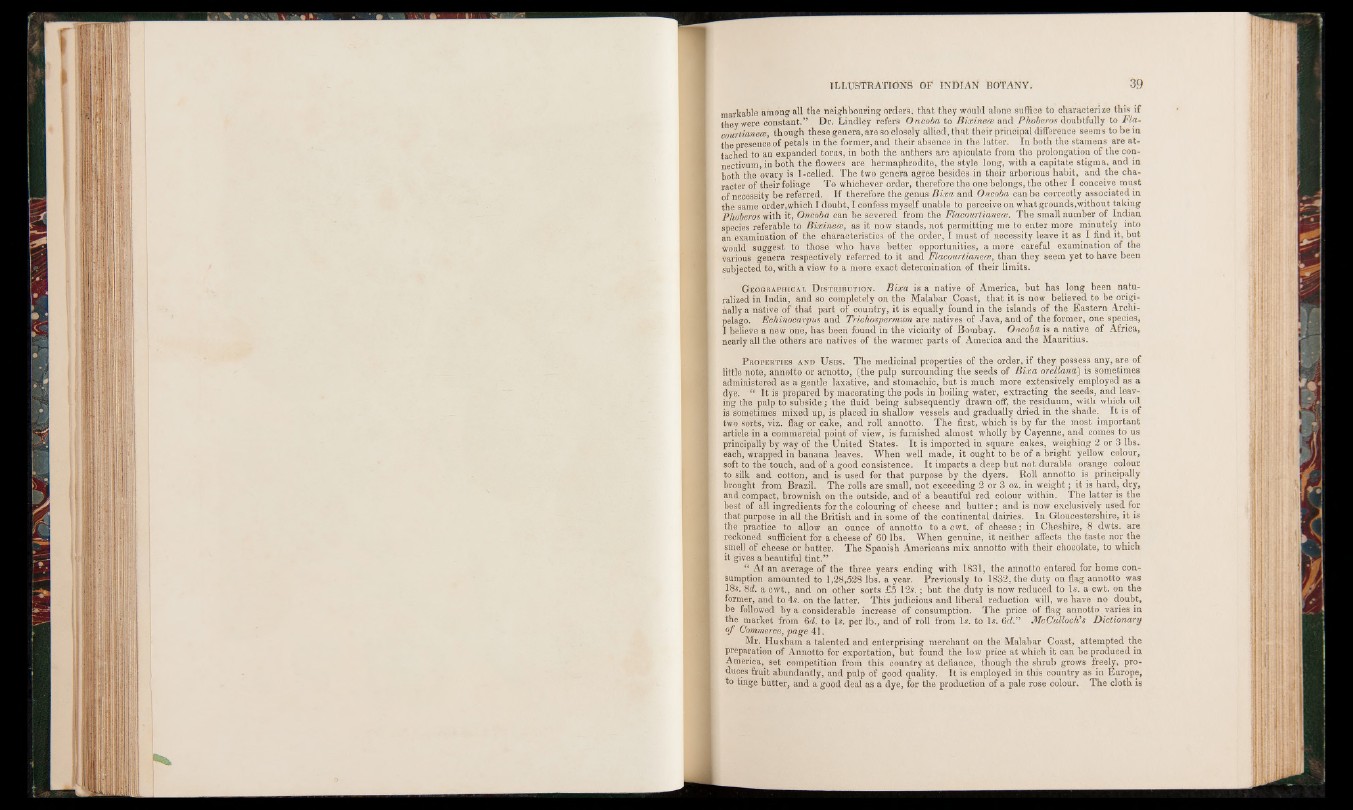
markable among all the neighbouring orders, that they would alone suffice to characterize this if
they were constant.” Dr. Lindley refers Oncoba to Bixinece and Phoberos doubtfully to Fla-
courtianece, though these genera, are so closely allied, that their principal difference seems to be in
the presence of petals in the former, and their absence in the latter. In both the stamens are attached
to an expanded torus, in both the anthers are apiculate from the prolongation of the con-
nectivum, in both the flowers are hermaphrodite, the style long, with a capitate stigma, and in
both the ovary is 1-celled. The two genera agree besides in their arborious habit, and the character
of their foliage To whichever order, therefore the one belongs, the other I conceive must
of necessity be referred. If therefore the genus Bixa and Oncoba can be correctly associated in
the same order,which I doubt, I confess myself unable to perceive on what grounds,without taking
Phoberos with it, Oncoba can be severed from the Flacourtianece. The small number of Indian
species referable to Bixinece, as it now stands, not permitting me to enter more minutely into
an examination of the characteristics of the order, I must of necessity leave it as I find it, but
■frould suggest to those who have better opportunities, a more careful examination of the
various genera respectively referred to it and Flacourtianece, than they seem yet to have been
subjected to, with a view to a more exact determination of their limits.
G eographical D istribution. Bixa is a native of America, but has long been naturalized
in India, and so. completely on the Malabar Coast, that it is now believed to be originally
a native of that part of country, it is equally found in the islands of the Eastern Archipelago.
Echinocarpus and TrichospermiCm are natives of Java, and of the former, one species,
I believe a new one, has been found in the vicinity of Bombay. Oncoba is a native of Africa,
nearly all the others are natives of the warmer parts of America and the Mauritius.
P roperties and U ses. The medicinal properties of the order, if they possess any, are of
little note, annotto or arnotto, (the pulp surrounding the seeds of Bixa orellana) is sometimes
administered as a gentle laxative, and stomachic, but is much more extensively employed as a
dye. “ It is prepared by macerating the pods in boiling water, extracting the seeds, and leaving
the pulp to subside; the fluid being subsequently drawn off, the residuum, with which oil
is sometimes mixed up, is placed in shallow vessels and gradually dried in the shade. It is of
tWo sorts, viz. flag or cake, and roll annotto. The first, which is fry far the most important
article in a commercial point of view, is furnished almost wholly by Cayenne, and comes to us
principally by way of the United States. It is imported in square cakes, weighing 2 or 3 lbs.
each, wrapped in banana leaves. When well made, it ought to be of a bright yellow colour,
soft to the touch, and of a good consistence. It imparts a deep but not durable orange colour
to silk and cotton, and is used for that purpose by the dyers. Roll annotto is principally
brought from Brazil. The rolls are small, not exceeding 2 or 3 oz. in weight; it is hard, dry,
and compact, brownish on the outside, and of a beautiful red colour within. The latter is the
best of all ingredients for the colouring of cheese and butter; and is now exclusively used for
that purpose in all the British and in some of the continental dairies. In Gloucestershire, it is
the practice to allow an ounce of annotto to a cwt. of cheese; in Cheshire, 8 dwts. are
reckoned sufficient for a cheese of 60 lbs. When genuine, it neither affects the taste nor the
smell of cheese or butter. The Spanish Americans mix annotto with their chocolate, to which
it gives a beautiful tint.”
“ At an average of the three years ending with 1831, the annotto entered for home consumption
amounted to 1,28,528 lbs. a year. Previously to 1832, the duty on flag annotto was
18s. 8d. a cwt., and on other sorts £5 12$.; but the duty is now reduced to 1$. a cwt. on the
former, and to 4$. on the latter. This judicious and liberal reduction will, we have no doubt,
be followed by a considerable increase of consumption. The price of flag annotto varies in
the market from 6d. to 1$. per lb., and of roll from 1$. to 1$. 6rf.” McCulloch* s Dictionary
of Commerce, 'page 41.
Mr. Huxham a talented and enterprising merchant on the Malabar Coast, attempted the
preparation of Annotto for exportation, but found the low price at which it can be produced in
America, set competition from this country at defiance, though the shrub grows freely, produces
fruit abundantly, and pulp of good quality. It is employed in this country as in Europe,
to tinge butter, and a good deal as a dye, for the production of a pale rose colour. The cloth is